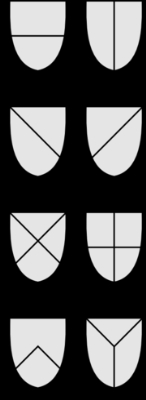
Division of the field
Encyclopedia
In heraldry
, the field
(background) of a shield can be divided into more than one area of different tincture
s, usually following the lines of one of the ordinaries
and carrying its name (e.g. a shield divided in the shape of a chevron is said to be parted "per chevron"). Shields may be divided this way for differencing (to avoid conflict with otherwise similar coats of arms) or for purposes of marshalling (combining two or more coats of arms into one), or simply for style. The lines that divide a shield may not always be straight, and there is a system of terminology for describing patterned lines, which is also shared with the heraldic ordinaries. French heraldry
takes a different approach in many cases from the one described in this article.
 Common partitions of the field are:
Common partitions of the field are:
Nowadays, however, the 'party' is often omitted, even in 'official' blazons, e.g. in letters patent and extracts of matriculation.
A field cannot be divided per bordure
(as, if this did exist, it would be indistinguishable from the bordure); though a bordure can. Neither can a field (nor any charge) be divided per chief, for similar reasons; though both Canadian and Scottish Public Registers have official records of fields or bordures divided 'per chief'. The earliest such record in the Scottish Public Register
is before 1677, "parted per chief azure and gules three skenes argent hefted and pomelled Or Surmounted of as many Woolf-heads couped of the third." and a bordure per chief is shown in the arms of Roy, Canada.
Although it is alleged that per chevron enhanced (with the division occurring higher than it normally would) is called mantled in English, this is a term of rare application. When the term rompu is applied to a division of the field, the result will take a number of different forms depending on the manner of division. The arms of Lois Hole
show Per chevron rompu Or and Vert, the centre section heightened of two points. (Rompu can also sometimes be applied to "common charges".) A field pily, as in the arms of Baron Marks of Broughton
, is similar to a field per fess dancetty, except that the teeth are much more exaggerated.
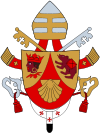 Shields may also be divided into three parts: this is called tierced, as in tierced per pale, azure, argent and gules (though perhaps in English heraldry
Shields may also be divided into three parts: this is called tierced, as in tierced per pale, azure, argent and gules (though perhaps in English heraldry
this is rarely if ever done, and the foregoing shield would be blazoned — as the pale is supposed to be one-third of the width of the field and is always so depicted under these circumstances — per pale azure and gules, a pale argent. but Scottish heraldry
does use 'tierced in pale' (e.g. Clackmannan county (now Clackmannanshire
) has Or; a saltire gules; a chief tierced in pale vert, argent, vert ...) A particular type of tiercing, resembling a Y in shape (division lines per bend and bend sinister coming down from the chief, meeting at the fess point, and continuing down per pale), is called per pall (also per pairle). The arms of Pope Benedict XVI is "tierced in mantle" - as described in Vatican information pages, but the usual term in, for example South African heraldry, is chapé ployé (with arched lines, with straigt lines: chapé (mantled)), which may be blazoned with three tinctures or just two - e.g. Okakarara Technical Institute: Gules, chapé Azure, on the partition lines respectively a bend and a bend sinister enhanced, in base a demi-cogwheel, Or, with a fountain issuant. Shields may also be divided into three parts by a combination of two methods of division, such as party per fess, in chief per pale. Another example is in the arms of Clive Cheesman
: per pale and per pall. This is to be distinguished from the essentially unique partition in the arms of the 2nd Weather Group
of the United States Air Force
, which is "Dexter
per chevron ployé and sinister per fess enhanced."
A shield may also be party per chevron reversed (inverted), which is like party per chevron except upside down. A section formed by two (straight) lines drawn from the corners of the chief to the point in base is called chaussé (shod), with arched or bent (French: ployé) lines it is called chaussé ployé.
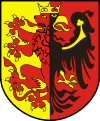 One common reason for dividing the field in heraldry is for purposes of combining two or more coats of arms to express alliance, inheritance, occupation of an office, etc. This practice, called marshalling, initially took the form of dimidiation
One common reason for dividing the field in heraldry is for purposes of combining two or more coats of arms to express alliance, inheritance, occupation of an office, etc. This practice, called marshalling, initially took the form of dimidiation
, or splicing together two coats of arms split down the middle (or sometimes, though rarely, split across the centre per fess or quarterly) so that half one coat was matched up with the opposite half of the other. As this would sometimes yield confusing or misleading results, the practice was supplanted by impalement
, which kept both coats intact and simply squished them into half the space. According to Fox-Davies (1909), the practice of dimidiation was short-lived and had already reached its peak in the early 14th century, while impalement remains in practice to modern times. One important remainder of the practice, however, is that when a coat of arms with a bordure is impaled with another coat, the bordure does not continue down the centre, but stops short where it meets the line of impalement. Eventually quartering
gained usage, and in the height of its popularity during the Victorian era
, some coats of arms featured hundreds of "quarterings" (see the Grenville arms at right). More usually, however, a quartered coat of arms consisted of four parts, as the name suggests. The origin and underlying purpose of quartering is to express inheritance by female succession: when a female heir (who has no brothers, or whose brothers have all preceded her in death) dies, her son (only after her death) quarters her arms with those of his father, placing the father's arms in the first (upper left) and fourth (lower right) quarters and his mother's arms in the second (upper right) and third (lower left).
In the UK heraldries, complex systems of marshalling have developed, and continue to thrive, around heraldic expressions of inheritance. In many cases of marriage, the shield is impaled with the husband's entire coat of arms placed on the dexter side and the wife's entire coat placed on the sinister side; if the wife is an heiress
, however, her arms are placed inescutcheon over her husband's (such usage is almost entirely English, Scots marshalling being impaling like any other marriage arms). If the husband is a knight of any order, however, the ensigns of that order belong only to him and are not shared with his wife. Two separate shields are then employed, the dexter shield bearing the husband's arms within the circle of his knighthood, and the sinister shield bearing the husband's arms impaled with the wife's usually encircled with a meaningless wreath of oak leaves for artistic balance. A male peer
impales the arms of his wife as described above, but including the supporters, coronet and helmet of the peer; if he is also a knight of any order, the two-shield method is used. If a female peer marries a commoner, however, the husband places her arms inescutcheon, surmounted by a coronet of her rank, over his own, but the supporters of her rank cannot be conferred to him; the wife bears her arms singly on a lozenge with the supporters and coronet of her rank. Volumes may be written on all the endless heraldic possibilities of this convoluted system of marshalling, but it may suffice here to say that for various purposes, arms may be marshalled by four basic methods: dimidiation by clipping and splicing two coats (usually per pale), impalement by dividing per pale and crowding an entire coat of arms into each half, quartering by dividing the shield into usually four (but potentially innumerable) "quarters", and superimposition by placing one coat of arms inescutcheon over another. It is also worth noting that one common form in German-Nordic heraldry is "quarterly with a heart" (a shield quartered with an inescutcheon overall). This may have stemmed from the continental practice of sovereigns placing their own hereditary arms inescutcheon over the arms of their dominions.
The arms of Novohrad-Volynskyi
, Ukraine
, show an unusual form of marshalling quarterly with a heart, where one quarter is dimidiated while the others are not.

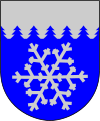
Divisions of the field, like the ordinaries, may follow complex line shapes. Most of these "sections" have developed conventional names in English, but modern artists, particularly in Finland, have developed new sections influenced by shapes found in the local flora. Among the most common of these are wavy, indented, dancetty (like indented but with bigger teeth), invected, engrailed, nebuly, embattled, dovetailed and potenty (pictured below). Notable modern forms include the "fir twig section" (havukoro in Finnish) and "fir tree top section" (kuusikoro in Finnish). These can be found in the arms of a number of municipalities in Finland, and the latter can also be found in the arms of Mullsjö Municipality in Sweden.
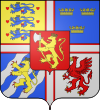 Besides the complex lines discussed above, divisions of the field may also be modified in other ways. Sometimes the division of the field may be fimbriated (lined) or, perhaps less properly, "edged" of another tincture, or divided by some ordinary or its diminutive. The latter differs from a parted field that then bears the ordinary, in that if the ordinary thus dividing the field is between charges, the charges are not overlapped by the ordinary but the ordinary is between them. A famous example of this is the greater arms of Sweden
Besides the complex lines discussed above, divisions of the field may also be modified in other ways. Sometimes the division of the field may be fimbriated (lined) or, perhaps less properly, "edged" of another tincture, or divided by some ordinary or its diminutive. The latter differs from a parted field that then bears the ordinary, in that if the ordinary thus dividing the field is between charges, the charges are not overlapped by the ordinary but the ordinary is between them. A famous example of this is the greater arms of Sweden
, which is "quartered by a cross Or..."
One division of the field (though it is sometimes described as a charge) is restricted to the chief: when the chief is divided by a bow-shaped line, this is called a chapournet or chaperonnet ("little hood"). Rompu, meaning "broken", is often applied to a chevron, where the center is usually broken and enhanced (brought to a sharper point than normal).
A number of divisions are unique to German heraldry, including per bend... broken in the form of a linden leaf.
The arms of the former Republic of Bophuthatswana were "per fess (at nombril point)" (lower than the regular per fess division; the "nombril point" is halfway between the fess point — the exact middle of the field — and the base point, at the bottom centre of the field).
The arms of the French department of Côtes d'Armor show émanché, which is shown in this case as equivalent to the English per fess dancetty of two full points upwards.
The arms of Mpumalanga Province in South Africa
show per bend sinister, inclined in the flanks per fess.
The arms of the White Workers Union in South Africa are blazoned Per chevron inverted extended Argent and Gules, in chief a pile Sable charged with two chevronels respectively Argent and Or.
Heraldry
Heraldry is the profession, study, or art of creating, granting, and blazoning arms and ruling on questions of rank or protocol, as exercised by an officer of arms. Heraldry comes from Anglo-Norman herald, from the Germanic compound harja-waldaz, "army commander"...
, the field
Field (heraldry)
In heraldry, the background of the shield is called the field. The field is usually composed of one or more tinctures or furs. The field may be divided or may consist of a variegated pattern....
(background) of a shield can be divided into more than one area of different tincture
Tincture (heraldry)
In heraldry, tinctures are the colours used to emblazon a coat of arms. These can be divided into several categories including light tinctures called metals, dark tinctures called colours, nonstandard colours called stains, furs, and "proper". A charge tinctured proper is coloured as it would be...
s, usually following the lines of one of the ordinaries
Ordinary (heraldry)
In heraldry, an ordinary is a simple geometrical figure, bounded by straight lines and running from side to side or top to bottom of the shield. There are also some geometric charges known as subordinaries, which have been given lesser status by some heraldic writers, though most have been in use...
and carrying its name (e.g. a shield divided in the shape of a chevron is said to be parted "per chevron"). Shields may be divided this way for differencing (to avoid conflict with otherwise similar coats of arms) or for purposes of marshalling (combining two or more coats of arms into one), or simply for style. The lines that divide a shield may not always be straight, and there is a system of terminology for describing patterned lines, which is also shared with the heraldic ordinaries. French heraldry
French heraldry
French heraldry is the use of heraldic symbols in France. Although it had a considerable history, like England, existing from the eleventh century, such formality has largely died out in France. The role of the herald in France declined in the seventeenth century...
takes a different approach in many cases from the one described in this article.
Common divisions of the field

- parted (or party) per fess (halved horizontally)
- party per pale (halved vertically)
- party per bend (diagonally from upper left to lower right)
- party per bend sinisterDexter and sinisterDexter and sinister are terms used in heraldry to refer to specific locations in an escutcheon bearing a coat of arms and by extension also to a crest. "Dexter" means to the right from the viewpoint of the bearer of the arms, to the left of that of the viewer...
(diagonally from upper right to lower left) - party per saltire (diagonally both ways)
- party per cross or quarterly (divided into four quarters)
- party per chevron (after the manner of a chevron)
- party per pall (divided into three parts in a Y shape)
Nowadays, however, the 'party' is often omitted, even in 'official' blazons, e.g. in letters patent and extracts of matriculation.
A field cannot be divided per bordure
Bordure
In heraldry, a bordure is a band of contrasting tincture forming a border around the edge of a shield, traditionally one-sixth as wide as the shield itself...
(as, if this did exist, it would be indistinguishable from the bordure); though a bordure can. Neither can a field (nor any charge) be divided per chief, for similar reasons; though both Canadian and Scottish Public Registers have official records of fields or bordures divided 'per chief'. The earliest such record in the Scottish Public Register
Public Register of All Arms and Bearings in Scotland
The Public Register of All Arms and Bearings in Scotland was established by Act of the Scottish Parliament in 1672. The register is held at the Court of the Lord Lyon and contains every grant of arms since that date. Bearings that are not matriculated in the Register may not be used in Scotland...
is before 1677, "parted per chief azure and gules three skenes argent hefted and pomelled Or Surmounted of as many Woolf-heads couped of the third." and a bordure per chief is shown in the arms of Roy, Canada.
Although it is alleged that per chevron enhanced (with the division occurring higher than it normally would) is called mantled in English, this is a term of rare application. When the term rompu is applied to a division of the field, the result will take a number of different forms depending on the manner of division. The arms of Lois Hole
Lois Hole
Lois Elsa Hole, CM, AOE was a Canadian politician, businesswoman, academician and best-selling author. She was the 15th Lieutenant Governor of Alberta from February 10, 2000 until her death...
show Per chevron rompu Or and Vert, the centre section heightened of two points. (Rompu can also sometimes be applied to "common charges".) A field pily, as in the arms of Baron Marks of Broughton
Baron Marks of Broughton
Baron Marks of Broughton, of Sunningdale in the Royal County of Berkshire, is a title in the Peerage of the United Kingdom. It was created in 1961 for Simon Marks. He was chairman and managing director of the retail chain Marks & Spencer, a company co-founded by his father Michael Marks...
, is similar to a field per fess dancetty, except that the teeth are much more exaggerated.

English heraldry
English heraldry is the form of coats of arms and other heraldic bearings and insignia used in England. It lies within the Gallo-British tradition. Coats of arms in England are regulated and granted to individuals by the College of Arms. They are subject to a system of cadency to distinguish...
this is rarely if ever done, and the foregoing shield would be blazoned — as the pale is supposed to be one-third of the width of the field and is always so depicted under these circumstances — per pale azure and gules, a pale argent. but Scottish heraldry
Scottish heraldry
Heraldry in Scotland, while broadly similar to that practised in England and elsewhere in western Europe, has its own distinctive features. Its heraldic executive is separate from that of the rest of the United Kingdom.-Executive:...
does use 'tierced in pale' (e.g. Clackmannan county (now Clackmannanshire
Clackmannanshire
Clackmannanshire, often abbreviated to Clacks is a local government council area in Scotland, and a lieutenancy area, bordering Perth and Kinross, Stirling and Fife.As Scotland's smallest historic county, it is often nicknamed 'The Wee County'....
) has Or; a saltire gules; a chief tierced in pale vert, argent, vert ...) A particular type of tiercing, resembling a Y in shape (division lines per bend and bend sinister coming down from the chief, meeting at the fess point, and continuing down per pale), is called per pall (also per pairle). The arms of Pope Benedict XVI is "tierced in mantle" - as described in Vatican information pages, but the usual term in, for example South African heraldry, is chapé ployé (with arched lines, with straigt lines: chapé (mantled)), which may be blazoned with three tinctures or just two - e.g. Okakarara Technical Institute: Gules, chapé Azure, on the partition lines respectively a bend and a bend sinister enhanced, in base a demi-cogwheel, Or, with a fountain issuant. Shields may also be divided into three parts by a combination of two methods of division, such as party per fess, in chief per pale. Another example is in the arms of Clive Cheesman
Clive Cheesman
Clive Edwin Alexander Cheesman is an officer of arms at the College of Arms in London, and is currently Richmond Herald, having been appointed on 7 April 2010. Cheesman was formerly a curator in the Department of Coins and Medals in the British Museum. He was Rouge Dragon Pursuivant of Arms in...
: per pale and per pall. This is to be distinguished from the essentially unique partition in the arms of the 2nd Weather Group
2nd Weather Group
The 2nd Weather Group, located at Offutt Air Force Base, Neb., delivers timely, relevant and specialized terrestrial, space and climatological global environmental intelligence to Joint warfighters, the United States Department of Defense, US Government agencies and nations allied with the United...
of the United States Air Force
United States Air Force
The United States Air Force is the aerial warfare service branch of the United States Armed Forces and one of the American uniformed services. Initially part of the United States Army, the USAF was formed as a separate branch of the military on September 18, 1947 under the National Security Act of...
, which is "Dexter
Dexter and sinister
Dexter and sinister are terms used in heraldry to refer to specific locations in an escutcheon bearing a coat of arms and by extension also to a crest. "Dexter" means to the right from the viewpoint of the bearer of the arms, to the left of that of the viewer...
per chevron ployé and sinister per fess enhanced."
A shield may also be party per chevron reversed (inverted), which is like party per chevron except upside down. A section formed by two (straight) lines drawn from the corners of the chief to the point in base is called chaussé (shod), with arched or bent (French: ployé) lines it is called chaussé ployé.
Marshalling

Dimidiation
In heraldry, dimidiation is a method of joining two coats of arms.For a time, dimidiation preceded the method known as impalement. Whereas impalement involves placing the whole of both coats of arms side by side in the same shield, dimidiation involves placing the dexter half of one coat of arms...
, or splicing together two coats of arms split down the middle (or sometimes, though rarely, split across the centre per fess or quarterly) so that half one coat was matched up with the opposite half of the other. As this would sometimes yield confusing or misleading results, the practice was supplanted by impalement
Impalement (heraldry)
In heraldry, impalement is the combination of two coats of arms side-by-side in one shield or escutcheon to denote union, most often that of a husband and wife, but also for ecclesiastical use...
, which kept both coats intact and simply squished them into half the space. According to Fox-Davies (1909), the practice of dimidiation was short-lived and had already reached its peak in the early 14th century, while impalement remains in practice to modern times. One important remainder of the practice, however, is that when a coat of arms with a bordure is impaled with another coat, the bordure does not continue down the centre, but stops short where it meets the line of impalement. Eventually quartering
Quartering (heraldry)
Quartering in heraldry is a method of joining several different coats of arms together in one shield by dividing the shield into equal parts and placing different coats of arms in each division....
gained usage, and in the height of its popularity during the Victorian era
Victorian era
The Victorian era of British history was the period of Queen Victoria's reign from 20 June 1837 until her death on 22 January 1901. It was a long period of peace, prosperity, refined sensibilities and national self-confidence...
, some coats of arms featured hundreds of "quarterings" (see the Grenville arms at right). More usually, however, a quartered coat of arms consisted of four parts, as the name suggests. The origin and underlying purpose of quartering is to express inheritance by female succession: when a female heir (who has no brothers, or whose brothers have all preceded her in death) dies, her son (only after her death) quarters her arms with those of his father, placing the father's arms in the first (upper left) and fourth (lower right) quarters and his mother's arms in the second (upper right) and third (lower left).
In the UK heraldries, complex systems of marshalling have developed, and continue to thrive, around heraldic expressions of inheritance. In many cases of marriage, the shield is impaled with the husband's entire coat of arms placed on the dexter side and the wife's entire coat placed on the sinister side; if the wife is an heiress
Inheritance
Inheritance is the practice of passing on property, titles, debts, rights and obligations upon the death of an individual. It has long played an important role in human societies...
, however, her arms are placed inescutcheon over her husband's (such usage is almost entirely English, Scots marshalling being impaling like any other marriage arms). If the husband is a knight of any order, however, the ensigns of that order belong only to him and are not shared with his wife. Two separate shields are then employed, the dexter shield bearing the husband's arms within the circle of his knighthood, and the sinister shield bearing the husband's arms impaled with the wife's usually encircled with a meaningless wreath of oak leaves for artistic balance. A male peer
Peerage
The Peerage is a legal system of largely hereditary titles in the United Kingdom, which constitute the ranks of British nobility and is part of the British honours system...
impales the arms of his wife as described above, but including the supporters, coronet and helmet of the peer; if he is also a knight of any order, the two-shield method is used. If a female peer marries a commoner, however, the husband places her arms inescutcheon, surmounted by a coronet of her rank, over his own, but the supporters of her rank cannot be conferred to him; the wife bears her arms singly on a lozenge with the supporters and coronet of her rank. Volumes may be written on all the endless heraldic possibilities of this convoluted system of marshalling, but it may suffice here to say that for various purposes, arms may be marshalled by four basic methods: dimidiation by clipping and splicing two coats (usually per pale), impalement by dividing per pale and crowding an entire coat of arms into each half, quartering by dividing the shield into usually four (but potentially innumerable) "quarters", and superimposition by placing one coat of arms inescutcheon over another. It is also worth noting that one common form in German-Nordic heraldry is "quarterly with a heart" (a shield quartered with an inescutcheon overall). This may have stemmed from the continental practice of sovereigns placing their own hereditary arms inescutcheon over the arms of their dominions.
The arms of Novohrad-Volynskyi
Novohrad-Volynskyi
Novohrad-Volynskyi is a city in the Zhytomyr Oblast of northern Ukraine...
, Ukraine
Ukraine
Ukraine is a country in Eastern Europe. It has an area of 603,628 km², making it the second largest contiguous country on the European continent, after Russia...
, show an unusual form of marshalling quarterly with a heart, where one quarter is dimidiated while the others are not.
Lines of division


Divisions of the field, like the ordinaries, may follow complex line shapes. Most of these "sections" have developed conventional names in English, but modern artists, particularly in Finland, have developed new sections influenced by shapes found in the local flora. Among the most common of these are wavy, indented, dancetty (like indented but with bigger teeth), invected, engrailed, nebuly, embattled, dovetailed and potenty (pictured below). Notable modern forms include the "fir twig section" (havukoro in Finnish) and "fir tree top section" (kuusikoro in Finnish). These can be found in the arms of a number of municipalities in Finland, and the latter can also be found in the arms of Mullsjö Municipality in Sweden.
 |
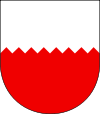 |
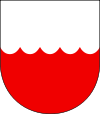 |
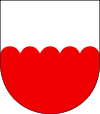 |
| Wavy | Indented | Engrailed | Invected |
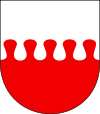 |
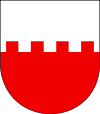 |
 |
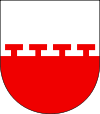 |
| Nebuly | Embattled | Dovetailed | Potenty |
Other modifications

Coat of arms of Sweden
The greater national coat of arms and the lesser national coat of arms are the official coats of arms of Sweden.- Escutcheon :...
, which is "quartered by a cross Or..."
One division of the field (though it is sometimes described as a charge) is restricted to the chief: when the chief is divided by a bow-shaped line, this is called a chapournet or chaperonnet ("little hood"). Rompu, meaning "broken", is often applied to a chevron, where the center is usually broken and enhanced (brought to a sharper point than normal).
Unusual forms
When the partition lines form four L-shapes, the field is blazoned quarterly en equerre (viz. "framing square", German Winkelmaßschnitt).A number of divisions are unique to German heraldry, including per bend... broken in the form of a linden leaf.
The arms of the former Republic of Bophuthatswana were "per fess (at nombril point)" (lower than the regular per fess division; the "nombril point" is halfway between the fess point — the exact middle of the field — and the base point, at the bottom centre of the field).
The arms of the French department of Côtes d'Armor show émanché, which is shown in this case as equivalent to the English per fess dancetty of two full points upwards.
The arms of Mpumalanga Province in South Africa
South Africa
The Republic of South Africa is a country in southern Africa. Located at the southern tip of Africa, it is divided into nine provinces, with of coastline on the Atlantic and Indian oceans...
show per bend sinister, inclined in the flanks per fess.
The arms of the White Workers Union in South Africa are blazoned Per chevron inverted extended Argent and Gules, in chief a pile Sable charged with two chevronels respectively Argent and Or.

